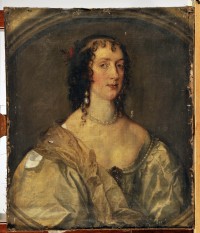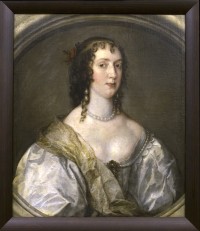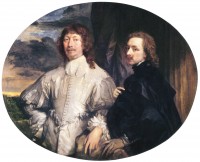 A painting by Flemish Baroque master Anthony Van Dyck has been discovered in storage at the The Bowes Museum by an expert who came across it on the BBC’s Your Paintings website. Art historian and dealer Dr. Bendor Grosvenor was perusing the Public Catalogue Foundation’s massive database of all 210,000 publicly owned paintings in the UK (online at the Your Paintings site) to research an upcoming exhibition when he spotted the Portrait of Olive Boteler Porter.
A painting by Flemish Baroque master Anthony Van Dyck has been discovered in storage at the The Bowes Museum by an expert who came across it on the BBC’s Your Paintings website. Art historian and dealer Dr. Bendor Grosvenor was perusing the Public Catalogue Foundation’s massive database of all 210,000 publicly owned paintings in the UK (online at the Your Paintings site) to research an upcoming exhibition when he spotted the Portrait of Olive Boteler Porter.
The portrait had been in the collection since the museum opened in the market town of Barnard Castle in north east England in 1892. It was purchased in Paris by the museum’s founder John Bowes in 1866. When he bought it both the sitter and artist were unidentified. The museum later determined the subject was Olive Boteler Porter, wife of Endymion Porter, a good friend of Van Dyck’s, and lady-in-waiting to Henrietta Maria, wife of King Charles I, but the painting was still listed as “a copy after Sir Anthony Van Dyck.”
Years of caked dirt and yellowed varnish had kept the portrait off the gallery floor and in storage. When Grosvenor raised the prospect that it could be a work by the master himself, the Bowes enlisted him and his colleagues at Philip Mould & Company who have conserved more than 20 Van Dyck’s to clean the painting. Taking a minimalist approach — removing all but the oldest layer of varnish and doing some minor retouching in areas where the paint was removed by prior cleanings, most notably in the left eye — conservators were able to reveal the glowing delicacy of the skin tones, fabric and draping.
 Philip Mould now officially confirmed that Grosvenor’s eye was unfailing, that the painting was a genuine Van Dyck. Other Van Dyck experts, including Christopher Brown, director of the Ashmolean Museum in Oxford and Rev. Dr. Susan Barnes, co-author of Van Dyck: A Complete Catalogue of the Paintings, were brought in to assess the cleaned portrait and they all agreed that it was the real thing. When Ms. Porter returned to the Bowes, she was given pride of place on the gallery wall. No more storage for her.
Philip Mould now officially confirmed that Grosvenor’s eye was unfailing, that the painting was a genuine Van Dyck. Other Van Dyck experts, including Christopher Brown, director of the Ashmolean Museum in Oxford and Rev. Dr. Susan Barnes, co-author of Van Dyck: A Complete Catalogue of the Paintings, were brought in to assess the cleaned portrait and they all agreed that it was the real thing. When Ms. Porter returned to the Bowes, she was given pride of place on the gallery wall. No more storage for her.
The wheel has come full circle for Olive Boteler Porter, who followed her husband out of the country in 1646 when all field resistance stopped in the Civil War and Parliament was in control of the country. Olive had taunted Parliament repeatedly. She had adopted the queen’s Catholicism in 1637 and was a most vigorous adherent of her new faith, converting several noblewomen and absconding with her dying father, brother of the Duke of Buckingham, in an attempt to save his immortal soul before it was too late. She and Queen Henrietta openly defied Parliament, flaunting their successful conversions in a parade at Christmas. The Puritan-dominated Parliament was not amused. They saw Olive as a fifth columnist, maybe even a spy for Spain, and that suspicion spilled over onto her husband even though he never converted.
 The painting was probably done around the time of her conversion. Van Dyck painted several portraits of her, alone and with her husband. Endymion Porter also bears the distinction of being the only person Van Dyck ever painted standing next to him in a double portrait now in the Prado Museum.
The painting was probably done around the time of her conversion. Van Dyck painted several portraits of her, alone and with her husband. Endymion Porter also bears the distinction of being the only person Van Dyck ever painted standing next to him in a double portrait now in the Prado Museum.
When the Porters fled England, they probably took the painting with them, which is how it ended up in France, and under great financial duress, sold it. There’s a wax collector’s seal on the back that marks it as property of either Henri, 2nd Duc de Montbazon (d.1654) or his son Louis (d.1667). Two hundred years later, John Bowes bought the painting from his favorite Paris Dealer along with another painting attributed to Van Dyck said to be of Henrietta Maria. That was the one from the school of Van Dyck, while the lady-in-waiting is the real deal.
When I blogged about the Public Catalogue Foundation’s project and the Your Paintings database in December 2011, they had just reached the halfway mark with 104,000 paintings uploaded. Less than a year later, all 210,000 public paintings in the UK were photographed and uploaded to the BBC website. Out of the 210,000 works by 45,000 artists, 30,000 of them are unattributed. It’s tremendously exciting that the online database is directly responsible for matching one of those orphans with its artistic father.
The saga of the newly discovered Van Dyck was the subject of a recent episode of The Culture Show (not available outside the UK), a BBC program hosted by Bendor Grosvenor. You can also read a fascinating account of the characteristics that mark the portrait as Van Dyck’s work and the research into its provenance on Grosvenor’s website.
So it’s no longer a Van Dyck in a box.
Bendor discovers lost Van Dyck. Amusing. :no: